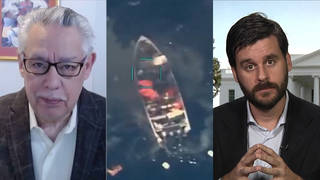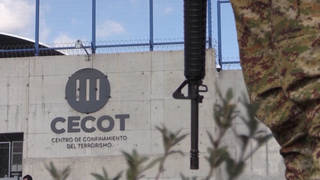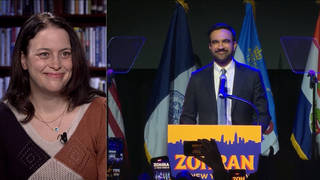
Guests
- Thaer Ahmademergency room physician who spent three weeks in Gaza volunteering at Nasser Hospital in Khan Younis.
Links
We get an update on conditions in southern Gaza’s Khan Younis area, where displaced Palestinians who fled there to seek refuge are reporting heavy aerial and tank fire as Israel intensifies its ground offensive around two main hospitals there. Dr. Thaer Ahmad is an emergency room physician who spent three weeks volunteering at Nasser Hospital in Khan Younis. “I thought, 'This can't be real.’ This is not something that I would expect in 2024,” says Ahmad, who worked alongside doctors who have been volunteering without pay for months as waves of Gazans, including their own families, seek help and safety at the remaining hospitals. “They assume that the hospital can be a sanctuary, and time and time again that has been proven incorrect in Gaza.”
Transcript
AMY GOODMAN: This is Democracy Now!, democracynow.org. I’m Amy Goodman.
We turn now to conditions in southern Gaza’s Khan Younis area, where displaced Palestinians who fled there to seek refuge are reporting heavy aerial and tank fire as Israel intensifies its ground offensive around two main hospitals there.
We’re joined in Chicago by Dr. Thaer Ahmad, an emergency room physician just back after spending three weeks in Gaza volunteering at Al-Nasser Hospital in Khan Younis, board member for MedGlobal, which has an office in Gaza, is working with the World Health Organization. Dr. Ahmad just returned to Chicago Thursday, where he’s the global health director of his hospital, also an assistant professor of emergency medicine at the University of Illinois, Chicago.
Dr. Ahmad, thank you so much for joining us. Tell us what you experienced in Khan Younis at the hospital.
DR. THAER AHMAD: [inaudible] hospitals that has surgical capabilities. You have thousands of people sheltering inside of the hospital, families sheltering right around the hospital in the area of the medical complex.
And what I saw was relentless bombing that was taking place, day and night. You saw many people who were injured, many of whom were children. Many were people who were just trying to go about their regular day, looking for where their next meal would come from, looking for where they could obtain water. And in the process of doing so, they were hit by tank shells or by airstrikes or by sniper fire. It was really horrific and overwhelming. I mean, I work at a Level I trauma center in Chicago, and the South Side of Chicago is no stranger to trauma or to gang violence. This was something that was on a level that I don’t think many people in America have ever experienced. Every aspect of life in Gaza has been affected, has been disrupted, has been made harder. And you really felt that while you were in the hospital.
The physicians that I was working alongside have been working nonstop for nearly four months. They also are hungry. They also are concerned about where they can get clean water from. Their families have been displaced multiple times. And they’re being asked to take care of waves and waves of people who are coming in as victims of bomb strikes or tank shellings.
You saw children walking around the complex barefoot. They looked like they were hungry looking for food. They were trying to just find some sort of refuge. They’re not going to school. They’re not getting vaccinated. They’re not going to their regular appointments.
And what we saw on the nights when it was really intensifying is a mass migration of people. I remember looking outside of the hospital window and seeing a 4-year-old girl holding onto her pillow and her dad hurriedly trying to grab whatever he could, and they were going to flee on foot further south, probably would have to walk five or six miles in the middle of the night, 3 or 4 a.m., as you heard F-16s above-head and the relentless bombing taking place. And I thought, “This can’t be real.” This is not something that I would expect in 2024 something to be happening. And I think that part of what we’re seeing is, you know, that these people are consistently being dehumanized and retraumatized.
So, it’s very simple to just say people are being asked to evacuate, people are being asked to go to a safer place. But what I realized very quickly, and what the doctors in Gaza told me, is that there is no place in Gaza that’s safe. There’s nowhere that you can take refuge. No place has been spared from bombing. And just because there might be an intense military campaign taking place in Khan Younis like there was, it doesn’t mean that Rafah, which is further south, would be any safer and wouldn’t be subject to any sort of bombing, and that the people in the north of Gaza were also suffering immensely.
I mean, I was there in the midst of an eight-day telecommunications blackout. And I remember the doctors there who were asked to work these 24-hour shifts, thinking about their families and not knowing what was going to take place, not knowing if they were OK, not knowing if they had eaten for the day. And so, that’s something that I think was traumatizing to really experience secondhand, and I was only there for less than three weeks. This is what they’ve had to deal with for four months.
AMY GOODMAN: Reports are, from the U.N., at least 300 healthcare workers have been killed in Gaza. Also, Al Jazeera, speaking to a doctor at Nasser Hospital, where you were, Dr. Ahmad, in Khan Younis, said 95% of staff fled to Rafah as Israeli forces, quote, “bomb anything in front of them.” So, how many people are taking refuge in Nasser in addition to the wounded? How many dead bodies are piling up? And how many medical staff are left?
DR. THAER AHMAD: Yeah, I mean, that’s something that was noticeably thinning every single day that the military assault was taking place in Khan Younis, that more and more staff had to leave the hospital to go take care of their families and make sure their families were safe. You can say that there was probably two dozen, in terms of medical staff and doctors, as well as nurses.
I just want to point out that none of these physicians or nurses have been paid also for the last four months. They received one payment of $200 in November. They otherwise are volunteering, essentially, and just trying to serve their people. And in the process of that, as you mentioned, many of them have been subjected to violence, have been killed. Many have been arrested, as well.
And so, that was one of the concerns, that when we were in Khan Younis and there was some serious, intense bombing taking place, is you saw that there was this sort of tension that existed. And I remember trying to say, “You know, I think the hospital should be safe.” And they very quickly said, “What would make you think that Al-Nasser Hospital in Khan Younis is any different than Shifa in Gaza City or Al-Indunisi Hospital or any of the other hospitals that have been attacked?”
What happens is, while these attacks are taking place, as you mentioned, people who have been killed, their bodies are left in the street. And it’s very dangerous for any sort of first responder to be able to go and try to retrieve the body or to try to bring somebody who’s wounded, so many people may die in the process. And so, you see healthcare workers digging mass graves to be able to bury some of the wounded there.
And there are thousands of people sheltering in the hospital. Amy, if you were to walk in Nasser Hospital, to go to any floor, you see people in every inch and every corner. They may have this small, thin mattress or a blanket over them, families congregating together, because they assume that the hospital can be a sanctuary. And time and time again, that has been proven incorrect in Gaza.
And so, again, people have no choice. They have nowhere left to go. And the hospital staff are overworked. And I understand that there’s this notion that, you know, the people of Gaza are different. I experienced that. They are so resilient, and they are so impressive, from every single corner or every single angle. They’re able to do so much with so little resources. And they are phenomenal physicians and healthcare workers. But why are we insisting that we keep pushing them to their limit, to the maximum limit? Why do we keep trying to test their superhuman capabilities? That’s something that I found really disturbing while I was there.
AMY GOODMAN: Dr. Thaer Ahmad, we’re going to ask you to stay after the show, and we’re going to continue our conversation with your eyewitness report on the ground in Gaza, now just back in Chicago, emergency room physician, volunteered at Al-Nasser Hospital in Khan Younis.











Media Options